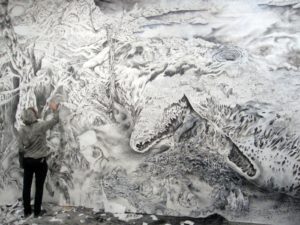Forestrial Brain is a collaborative project by artists Jim Holyoak and Matt Shane that’s centred on the wild imagery of Vancouver Island’s rugged west coast. The duo spent eight days hiking the island’s famous West Coast Trail, documenting what they observed and drawing sketches of all the different plants, animals, and landscapes that they encountered along the way.
“It’s an incredible hike to do,” says Shane. “I think that stretch of coastline is just so dramatic; the trees are so incredibly huge sometimes, and the coastline is so rugged and has such big rocks all over… it’s a dramatic place to be. So it was inspiring in its own right to be there and to feel so small next to these natural phenomena. One thing that really struck me was the cycle of life and death, to see these logs and trees that had fallen over and then become nurse logs that other trees will grow out of, and how the forest is always shifting and changing. It’s hard to determine when something is dead and something is born. Life and death are very fluid concepts there.”
Holyoak and Shane met at the University of Victoria, where they were both studying general arts. Just a year later they dropped out for a period of time to travel across Asia, as the pair had a mutual urge to travel and see the world.

“I’ve always been really interested in the monstrous and the grotesque my whole life,” says Holyoak. “When you’re hiking on the West Coast Trail, it’s like you’ve shrunk into this tiny walker that is surrounded by these monstrous trees and you’re really crawling up their toes with these root systems. So when I’m drawing these things I’ll often tweak them just a little bit farther. Because they’re already looking almost animal or human, it’s not too much of a stretch to add an eye so all of a sudden it becomes part plant, part creature.”
Holyoak says that this creates a “metamorphosis mixed with the monstrous and the fantastical, a sort of magical sense that things can transform into other things that we want to describe,” he says.
“This could be from plant to animal, but it also might just be from stone to gas, for instance,” he continues. “We’re interested in reaching outside these boxes that normal discipline is put in.”
The drawings and sketches that were done by Holyoak and Shane while on the trail were in pencil on regular paper. It was once they returned to the city, however, that the duo used Chinese ink, brooms, and brushes to transfer their sketches onto a long strip of paper—almost resembling a giant scroll—that stretches around the room from floor to ceiling, cut precisely to fit the architecture and held up with staples.
“We had a loose plan and a loose composition,” says Shane. “Drawing was a great way for us to just think about our surroundings and our position within the environment, and we’ll always encounter differences and things we couldn’t have predicted at the beginning. We’re trying to draw attention to the non-human and show that these kinds of creatures and entities have an importance and are worthy of consideration; trying to expand our imaginations beyond not only what it’s like to be another person but what it would be like to be a non-human, and how these creatures coexist with us.”
Forestrial Brain
Until Saturday, August 26
By donation, Open Space
openspace.ca
